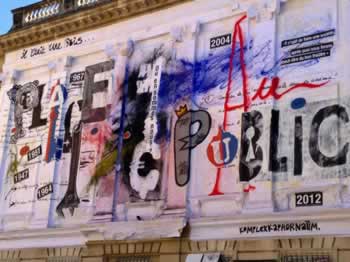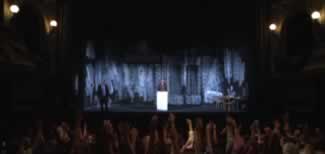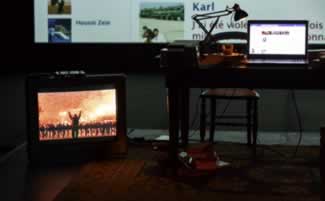
VIBES OF VILAR:
Political Theater at the 66th Avignon Festival
By Cyrielle Garson
The 66th Avignon Theater Festival was extremely successful. [1] It was a tribute to Jean Vilar, who would have celebrated his 100th birthday this year. Vilar, a major theoretician of popular theater, created the Avignon Festival in 1947 with the intention of bringing theater to the masses: “If the theater is not at once both moving and popular it is nothing. Our ambition is thus clear: to share with the biggest number that which was until now believed to be reserved for an elite.” [2]
An exhibition to commemorate his centennial was held in the Maison Jean Vilar accompanied by a series of meetings, readings and performances. An open-air performance mixing music, fireworks, street art and special effects by the collective KompleXKapharmaüm took place on July 14th at the Place du Palais des Papes to celebrate Vilar’s life and work. Many initiatives were implemented this year to bring theater to as wide an audience as possible: from efforts to attract young people who had never been to the theater, to including local prison inmates. [3] Curators Hortense Archambault and Vincent Baudriller appointed British director and actor Simon McBurney to prepare the 2012 programme. Each year, they choose a different artist for this task whose artistic sensibility and approach serve as a prism through which theater can be envisioned. In previous years, the position was occupied by renowned European directors Romeo Castellucci and Thomas Ostermeier as well as Lebanese-Canadian writer/actor/director Wajdi Mouawad.
As the British critic Matt Trueman pointed out, this year’s programme, which included 42 performances, allowed audiences to journey through the Festival following numerous “connecting threads.” [4] There were many, but this essay focuses on the politically oriented performances that took place. Another thread was the relationship between theater and literature. Five interesting productions were based on novels: Simon McBurney’s The Master and Margarita, adapted from Bulgakov; Katie Mitchell’s Rings of Saturn, inspired by W.G. Sebald; Coetzee’s Disgrace, adapted by Hungarian director Kornél Mundruczó; W/GB84 by J-F. Matignon, based on David Peace’s GB 84; and Christophe Honoré’s Nouveau Roman, focused on the French writers of the Nouveau Roman in the late 1950s such as Marguerite Duras and Claude Simon. The political thread seems to me more interesting.
One of the most impressive moments of the festival happened in the Court d’Honneur of the Papal Palace on the very first day when the character Professor Woland in Simon McBurney’s high-tech version of The Master and Margarita asked the audience the following question: “Have the citizens changed on the inside?” As he uttered these words, the massive medieval wall of the Palace facing the audience turned into a gigantic (camera-controlled) mirror reflecting all the spectators and blurring the frontier between stage and audience, reality and fiction. The audience was thus left to ponder whether technological advances were a synonym for progress. Such questions were intended to go beyond relations of power and ideology to interrogate the very notion of “humanness.”
Elements of answers were suggested throughout the festival. Indeed, some of the most pressing issues of our time were discussed, from the economic crisis to our planet’s finiteness as demographic pressure has grown exponentially: “your children will live in a world of ten billion,” said Cambridge-based scientist Stephen Emmott in Katie Mitchell’s Ten Billion. These issues were not only articulated by the curators in the programme materials but also made the subject of numerous debates and public events. French philosopher Alain Badiou, for instance, reflected in his lecture “In Praise of the Theater” on why theater is a vital form of communication in today’s neocapitalistic order. And in a forum called “Theater of Ideas,” two economists tried to answer the question: how can we think of, and perform, the crisis?
This year's crop of shows stressed productions that questioned and expanded the boundaries of theatrical forms and the way theater seeks to influence political debates. Indeed, the festival proved to be both a showcase and a laboratory for theater today, as its founder intended. Five productions could be described as documentary theater in some sense: Bruno Meyssat’s 15% (about the financial crisis); Mapa Teatro’s Los Santos Inocentes (about political violence in Columbia); Lina Saneh and Rabih Mroué’s 33 rounds and few seconds (about political violence in Lebanon); and Thomas Ostermeier’s version of Ibsen’s An Enemy of the People and Mitchell’s Ten Billion (both about environmental risks). The discussion forum “Conversations at the Ecole d’Art” centered on the question: “Does documentary theater really exist?”
These and other productions materialized politics through the representation of past and present political figures. Stalin made a few brief appearances in McBurney’s The Master and Margarita. Margaret Thatcher was present, while Hitler was reduced to a puppet, in Matignon’s W/GB 84. Masks were used in Efriede Jelinek’s The Merchants’ Contracts: An Economic Comedy to allude to Angela Merkel, François Hollande, Barack Obama and Christine Lagarde. Silvio Berlusconi appeared in Fanny Bouyagi’s Soyez les bienvenus (Welcome), a poignant documentary exhibition on immigration and refugees. George W. Bush was a fleeting voice in Meyssat’s 15%. An official visit by the current French President (the first since 1981) was symbolically significant, as was a public discussion with McBurney, Castellucci and Ostermeier on the question of a politically-committed theater. During the three weeks of the festival, Avignon was converted into a public forum that questioned what had become of theater, its strengths and vivacity, as well as its promise in our time of crisis. According to British playwright Edward Bond, we are now living in the “third crisis,” the “materialised source” of which is “capitalism and its market.” [5]
Representing the Crisis
“Finance is to us what war was to Shakespeare,” Bruno Meyssat
“Money eats money,” Elfriede Jelinek
“The economy is not in crisis, the economy is the crisis,” The Invisible Committee [6]
How can one represent the crisis when finance tends to escape representation? The Avignon Festival answered this question with two very different works: Meyssat’s densely visual, partly verbatim piece 15% and Nicolas Stemann’s dynamic version of Nobel-winner Jelinek’s The Merchants’ Contracts: an Economic Comedy. Most theater about economic hardship focuses on victims. Only on rare occasions has theater managed to adequately elucidate the generative mechanisms behind something like the current global financial crisis. [7] Meyssat’s approach goes against the sort of representational realism that would seek to portray traders’ lives, and deals instead with the impact of financial pressure on the body.
15% stands for RoE, return on equity, which is the net profit after interest and tax that a stock or fund shareholder earns. According to the Avignon Festival website, before the financial crisis, a 15% RoE was “THE figure par excellence: the one that indicated the minimum percentage return on equity that pension funds investing in a company's capital expected.” Above 15% was a sign that the company was in good health and below 15% was a sign of trouble. 15% was in fact an average target rate. Some investment banks set a higher target of 20% beginning in the 1990s.
The production 15% is split into a series of visual sequences where actors express their inner worlds through the symbolic representation provided by objects. Verbatim extracts from various speeches (Bush, Milton Friedman...) during the subprime crisis, Wall Street crash, the Madoff and Kerviel affairs complete the picture. The actions performed on stage—such as cutting up a man’s shirt with scissors, putting on a wet shirt, grinding paper into pieces with a lawnmower—elude simple interpretation and were harshly received by some audience members. Meyssat establishes no consistent characters or narratives and leaves the spectator in a state of confusion. He invites us to rethink the identity of perpetrators and victims, to make a connection between our unconsciouses and those of the actors, and to imaginatively enter the crisis.
Jelinek’s The Merchants’ Contracts focuses on the use of neoliberal language to denounce the mechanisms of the crisis. Scrutiny of the often cold language of mathematics and economics reveals both emotional affect and irrationality, suggesting human forces at work. Jelinek’s use of economic rhetoric, whether meant literally or metaphorically, is both delectable and subversive. Capitalism is depicted as a product of human subjects (and their institutions) rather than the sole product of institutions. More than an economic system, for Jelinek, capitalism is a belief system where no one is innocent, not even the ruined pensioners who helped build the financial house of cards in the play. Despite the performance’s duration (four hours without intervals), and the subtleties and complexities of the text, the audience’s experience is a jubilatory one, in a context of improvisation, exultation, singing and reading. Director Nicolas Stemann’s choices not only resist commodification; they also celebrate the destruction of money. One actress eats real banknotes. Another burns them.
Ostermeier’s An Enemy of the People did not explicitly deal with the current crisis until Dr. Stockmann, the ambiguous hero of Ibsen’s play, read an extract from the French anti-capitalistic manifesto The Coming Insurrection (published by the anonymous The Invisible Committee) in an attempt to convince the citizens of his town that environmental protection was more important than economic growth. Spectators were asked to express their agreement or disagreement through a raised-hand vote. The lights were suddenly turned on and a real debate took place in the midst of the performance, with German actors accompanied by translators stepping into the auditorium and answering direct questions. Many questions were raised and the values of democracy itself were questioned. Ecological questions were intertwined with social and political concerns: do we so exploit our planet with our form of economy that it will not survive? Scientist Stephen Emmott in Katie Mitchell’s Ten Billion presented compelling evidence that planet earth is now reaching a “catastrophic tipping point.”

Theater without Actors
In Ten Billion, from the Royal Court Theatre in London, Emmott starts with a reminder of his status—“I’m a scientist, not an actor”—deliberately breaking theatrical illusion for political effect. This is not the first time Avignon festival-goers have been confronted with direct testimony. More tragically, Groupov’s Rwanda 94 opened the 1999 Avignon Festival with Yolande Mukagasana’s testimony: “I am not an actress, I am a survivor of the Rwanda genocide.” The use of real people in place of actors is usually intended to create an empathetic bond with listeners and a responsibility to respond.
33 rounds and few seconds goes even further and does without actors entirely, staging the notion of absence in a multi-media installation. This “mediaturgy” of absence revolves around the figure of Diyaa Yamout, a young Lebanese artist and human rights activist based on a real figure, Nour Merheb, who supposedly committed suicide in Beirut in October 2011 during the Arab Spring uprising. [8] Yamout, we are told, belonged to a secular group which was trying to find an alternative to the two main political camps in Lebanon: the March 8 Alliance and the March 14 Alliance. He might have committed suicide, but he couldn’t stop the authorities from manipulating the truth surrounding his death for their political gain. His death is subject to manipulation by various social networks such as Twitter and Facebook, by politicians, by the media and by extension by the Lebanese society as a whole.
The premise of these works is obviously that theater can make a difference, however small. Both Mitchell and Emmott seem to believe in the profundity and scope of their enterprise despite the pessimistic content of Ten Billion. More than 90% of the piece consists of statistics that Emmott says are “critical to understanding our future right now.” He gives his personal opinion on the ecological costs in the last ten minutes: “I don’t think we will [change our behavior], we’re fucked.” But the post-show discussion held after the performance I saw suggested that all hope is not lost. Emmott stated that educating the next generation remains a priority and the audience clearly left with increased awareness. Afterward, Mitchell and Emmott engaged in a passionate discussion with a group of young people outside the performance venue.

This year’s Avignon Festival highlighted contemporary theater-making’s most urgent artistic and ideological concerns. Attention was drawn to recurring themes, many of which were openly political, as the Festival established a number of productive tensions and crossovers between new media, dance, literature and theater. Following Vilar’s conception, audience interaction was vital to each production, as was political engagement.
Next year’s Festival will be the last one for the current curators, Archambault and Baudriller. They will work alongside two newly appointed associate artists, Congolese director Dieudonné Niangouna and French director Stanislas Nordey. Both have already presented political theater pieces at the Avignon Festival: Norday staged Falk Richter’s play about the Iraq war, Das System, in 2008 and the following year Niangouna dealt with the recent civil wars in Congo in Les Inepties volantes (Flying Paps). Let us hope that next year’s line-up will be as politically engaging and stimulating as this year’s.
NOTES:
1. A Festival report for 2012 gives an average attendance rate of 93%, corresponding to 135,800 patrons: http://www.festival-avignon.com/en/Bilan. For practical reasons this article discusses only the official Festival activities, “the IN,” and not its fringe counterpart “the OFF,” which included over a thousand shows.
2. Quoted from Jean Vilar, Le Théâtre Service Public et autres textes (Paris: Gallimard, 1975), p.173. All translations from French are mine.
3. On July 11th, British novelist John Berger, actress Juliette Binoche and Simon McBurney performed a reading of John Berger’s From A to X in front of seventy inmates in Le Pontet near Avignon.
4. Matt Trueman, “Avignon festival week two roundup: Seagull dead in the water, but Ibsen comes alive”, Guardian, July 12, 2012. http://www.guardian.co.uk/stage/2012/jul/25/avignon-festival-chekhov-ibsen?INTCMP=SRCH
5. Quoted from Edward Bond, “The Third Crisis” in The Chair Plays (London: Methuen Drama, 2012), p. xxxix.
6. Meyssat quoted from his company’s Web site: http://www.theatresdushaman.com/article89.html (“La finance étant pour nous tous ce que la guerre et ses combines ont été pour Shakespeare quand il décrivait les hommes de son temps”). Jelinek (“Geld frisst Geld”) quoted from the unpublished performance text used by Stemann in Avignon, p. 58. The Invisible Committee quoted from The Coming Insurrection (London: Continuum, 2007), p. 42.
7. Lucy Prebble’s Enron and David Hare’s The Power of Yes are two recent examples of successful endeavours.
8. “Mediaturgy” derives from the supposedly obsolete notion of dramaturgy (i.e. the composition of a dramatic text) and indicates a new way of staging post-dramatic performances. The concept was coined by Bonnie Marranca to designate “a work that embeds media in the performance rather than simply using it as illustration or decoration.” Bonnie Marranca, "Performance as Design: The Mediaturgy of John Jesurun’s Firefall," PAJ 32.3 (2010), p. 16.
Photos by Cyrielle Garson, copyright Avignon Festival.
